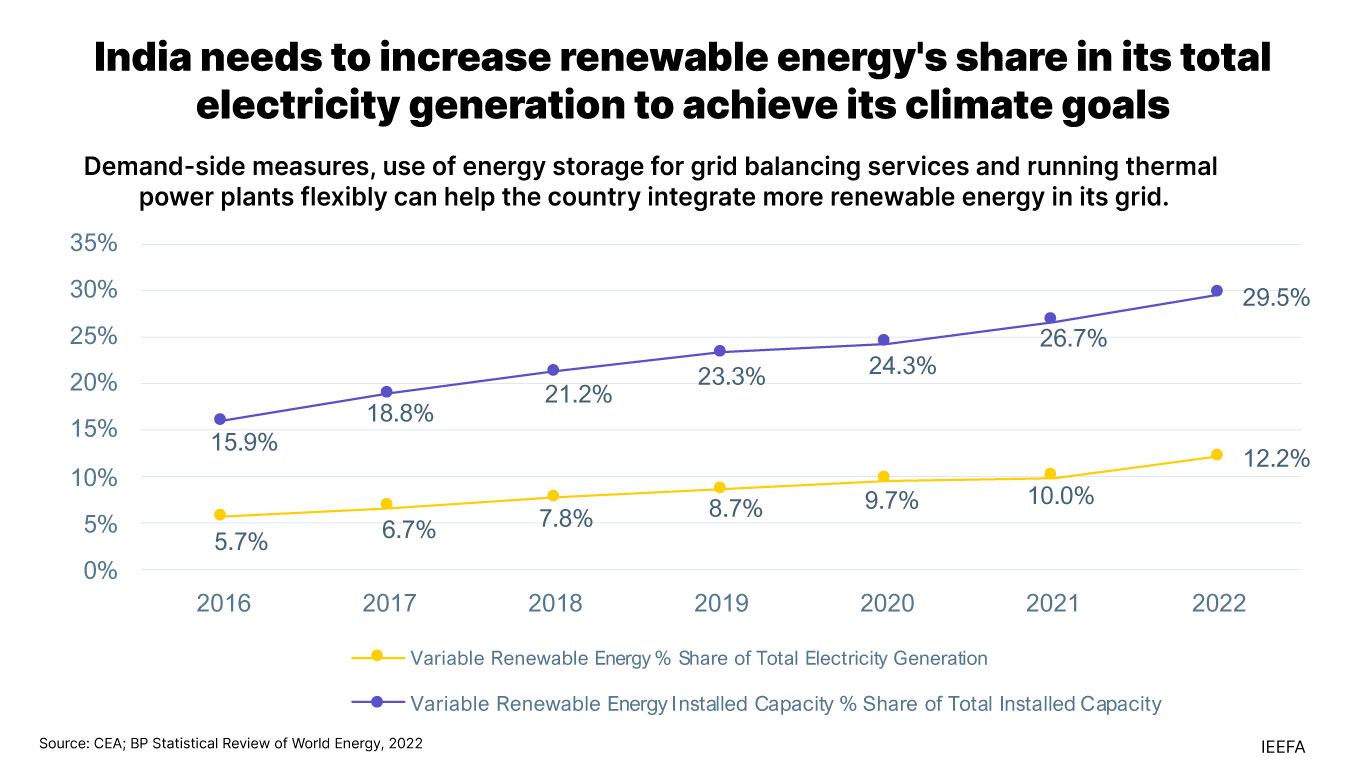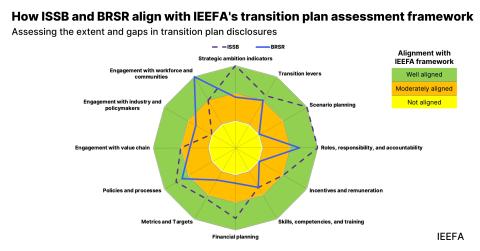Integrating more renewable energy in power system is crucial for India to meet climate goals

Demand-side management measures, building a large, well-connected national grid, deployment and efficient use of energy storage systems and flexible operation of thermal power plants are ways to help India reduce the emissions intensity of its economy by 45% by 2030 from 2005 levels.
Key Takeaways:
To cut emissions, India needs to increase renewable energy integration/absorption. Between 2016 and 2022, renewable energy’s share in total electricity generation grew only by 6.5 percentage points, while its share in total capacity addition grew by 13.6 percentage points.
Demand-side measures and expanded transmission network will help in reducing grid balancing needs and will also help in integrating renewable energy.
Energy storage technologies can be utilised to provide a variety of grid-balancing services.
Running existing coal or gas power plants at low load factors and flexibly to stabilise the grid will help increase the share of variable renewable energy in the electricity supply mix. A renewable energy rich power system will aid in the decarbonisation of other sectors, such as transportation and manufacturing industry.
13 July (IEEFA South Asia): While India has been adding renewable energy capacity at a fast pace, a new report by the Institute for Energy Economics and Financial Analysis (IEEFA) finds that to meet its emissions intensity reduction target for 2030, the country needs to ramp up the share of clean energy in its power system.
The report recommends four ways the country can do this – introducing demand-side measures like time-of-use tariffs, developing a well-connected national grid, deploying various energy storage options for grid balancing services and convert its fossil-fuel powered fleet to operate in a flexible manner.
“For India to meet growing electricity demand while addressing climate concerns, increased integration of clean energy, including variable renewable energy is essential,” says the report’s author Charith Konda, Energy Analyst, IEEFA.
“While raising non-fossil fuel power's installed capacity share to 50% by 2030 may be relatively easier to achieve, reducing the emissions intensity of its economy by 45% by 2030 from 2005 levels requires increased integration of variable renewable energy in the power system,” he adds.
According to the report, India can use a few potential levers to increase renewable energy integration in the power system.
“One of the immediate levers is introducing effective time-of-use (ToU) electricity tariffs to change consumption patterns to suit more renewable energy integration and lower grid balancing requirement. India should adopt a step-wise approach of introducing dynamic ToU electricity prices across consumer segments to reap the benefits,” says Konda.
The report also notes that the union government has started to take some demand-side measures by recently issuing guidelines for a range of tariff variations to be achieved from normal tariff during solar power generation and peak periods, which is 10-20% lower and 10-20% higher, respectively.
“Still, India needs dynamic ToU tariffs rather than static ones. Studies suggest that successfully implementing a dynamic ToU pricing regime can reduce peak demand by 5-25%,” says Konda.
The report also suggests that a well-connected national grid that transcends several regions ensures optimal utilisation of uneven distribution of energy sources.
“A strong inter-regional grid will better absorb and balance regional variations in renewable energy generation and reduce renewable energy curtailment,” says Konda.
“India is on the right path in proactively building the transmission infrastructure, which would, in turn, help integrate more renewable capacity into the power system and improve grid stability,” he adds.
Regarding energy storage solutions, the report finds that Pumped Hydro Storage (PHS) projects and Battery Energy Storage Systems (BESS) are promising among energy storage technologies that can play a crucial role in grid-balancing services.
“As a next step, the country should widen the scope of energy storage applications to provide a variety of grid balancing services rather than viewing energy storage in one dimension of firming renewable energy supply,” says Konda.
Finally, the report also finds that the Indian government’s plan to convert coal-based power plants to operate flexibly to accommodate more renewable energy may hold some benefits of lower capital expenditure requirements and reducing the curtailing of variable renewable energy in the medium term.
“Running coal plants flexibly can save already-established coal power plants from getting stranded. It also increases the per unit cost of coal power, making renewable energy plus storage more competitive in the merit order dispatch system,” says Konda.
“Converting India's coal power fleet to run flexibly will lead to some technical, financial, and regulatory/contractual challenges. The solutions include identifying suitable plants for conversion into flexible plants based on technical and financial parameters, redesigning coal power purchase contracts, and developing markets that allow flexible operations,” he adds.
Read the report: Integrating Higher Share of Variable Renewable Energy in India
Media contact: Prionka Jha ([email protected]) Ph: +91 9818884854
Author contacts: Charith Konda ([email protected])
About IEEFA: The Institute for Energy Economics and Financial Analysis (IEEFA) examines issues related to energy markets, trends, and policies. The Institute’s mission is to accelerate the transition to a diverse, sustainable and profitable energy economy. (ieefa.org)











